Lecture 4 Classical School After Smith and Ricardo

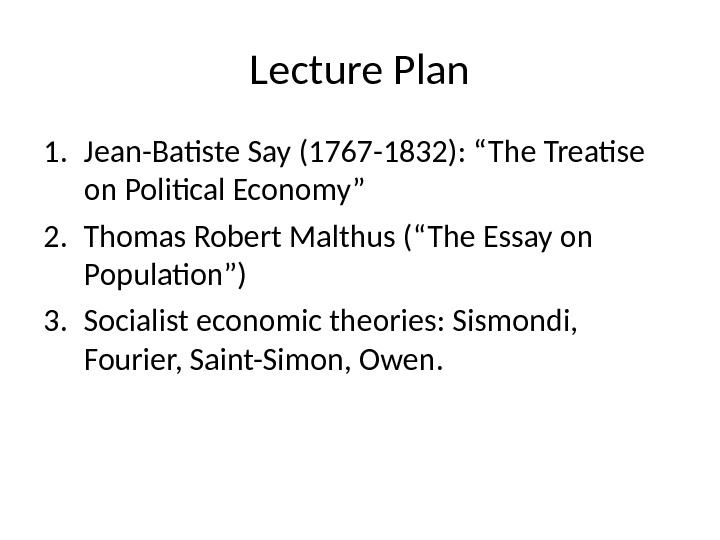
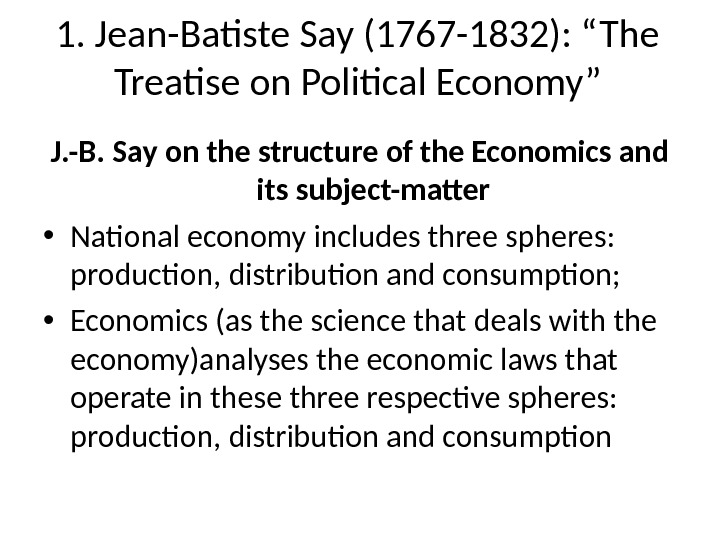

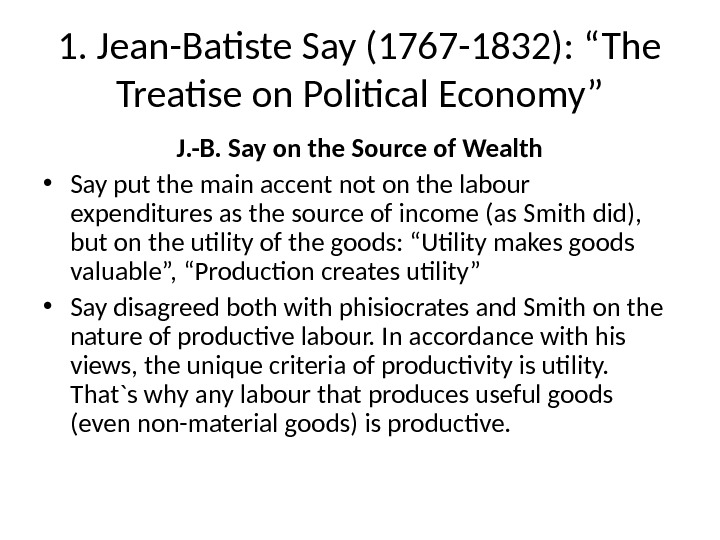

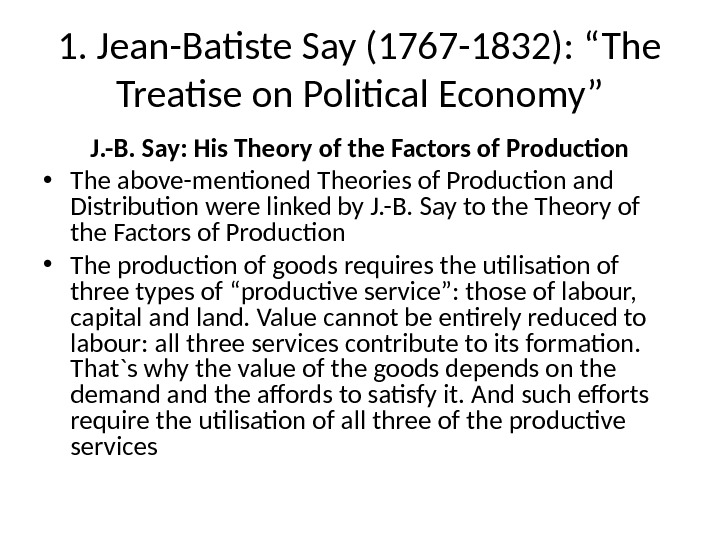
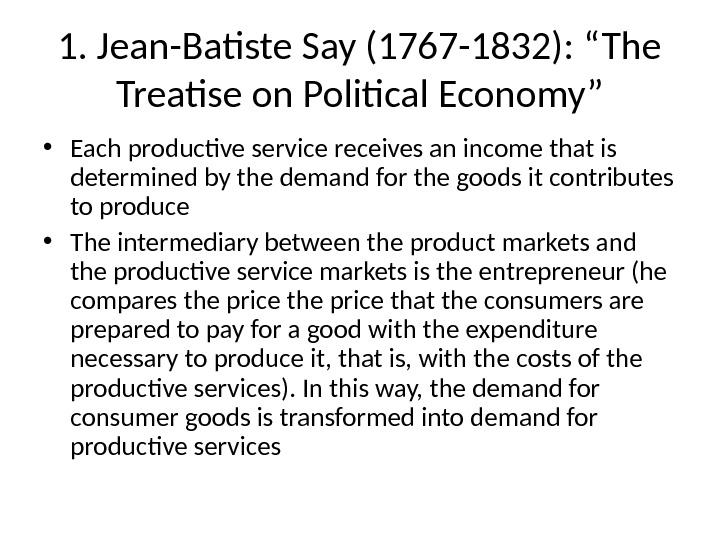


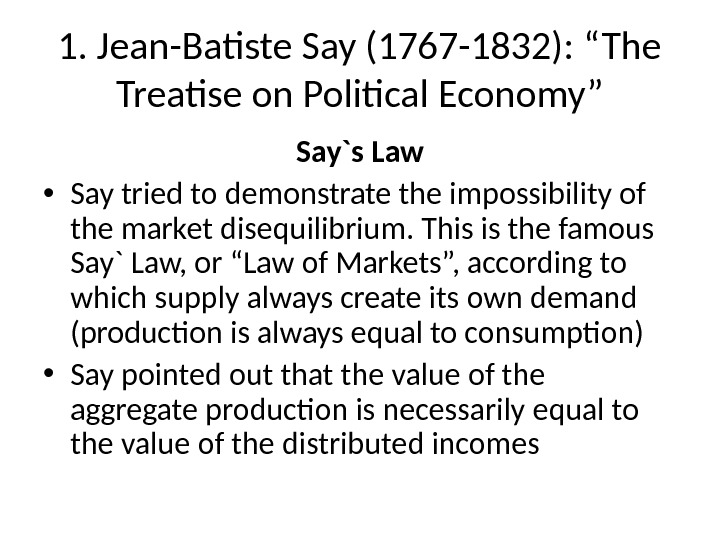

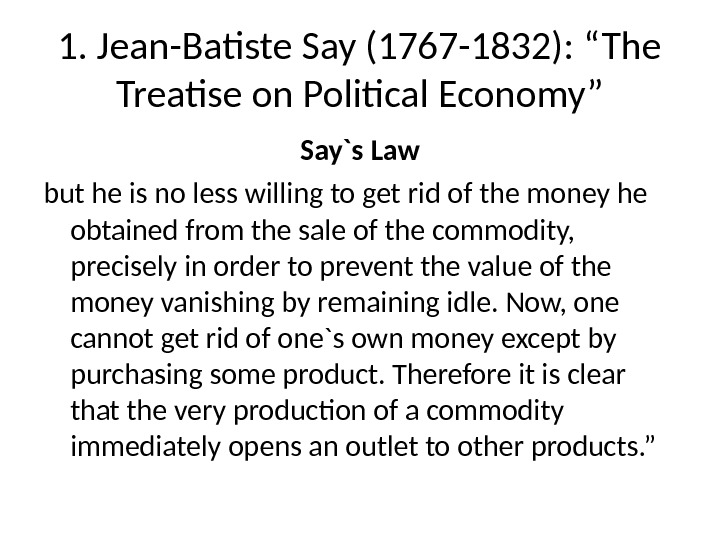
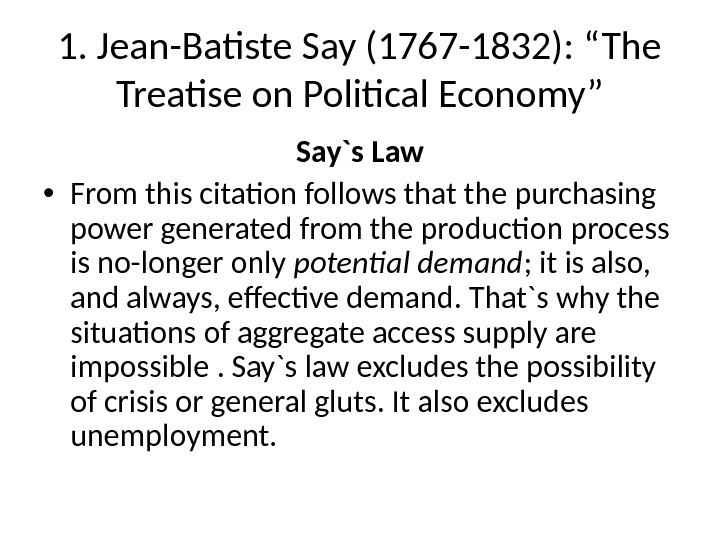

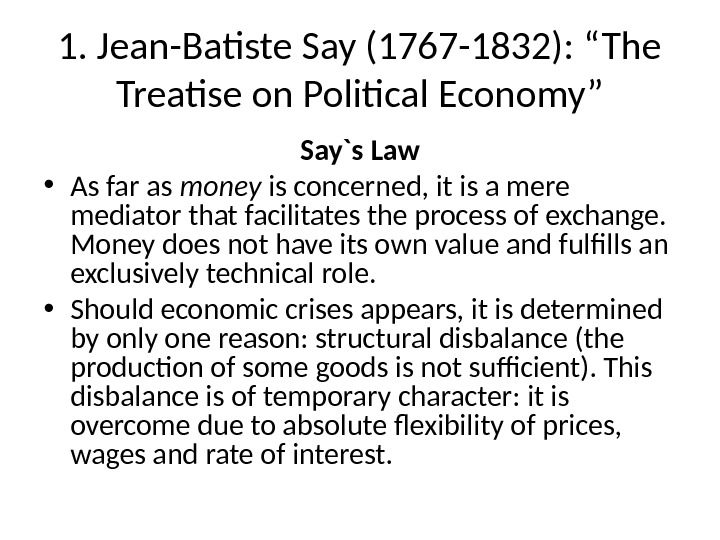

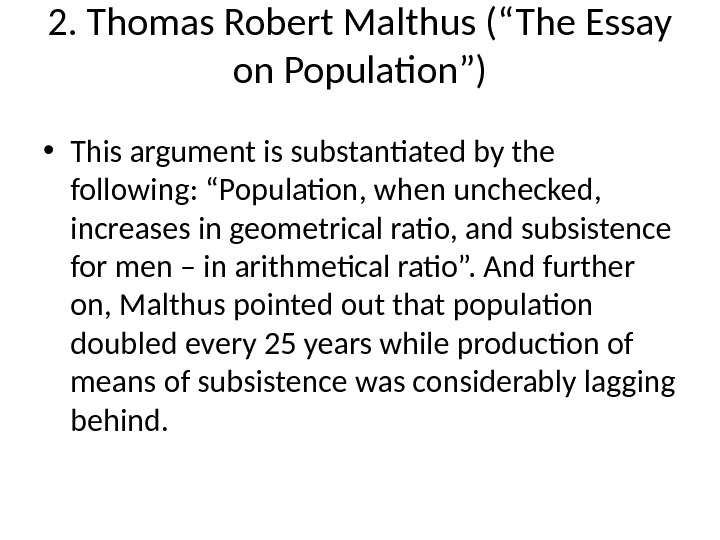

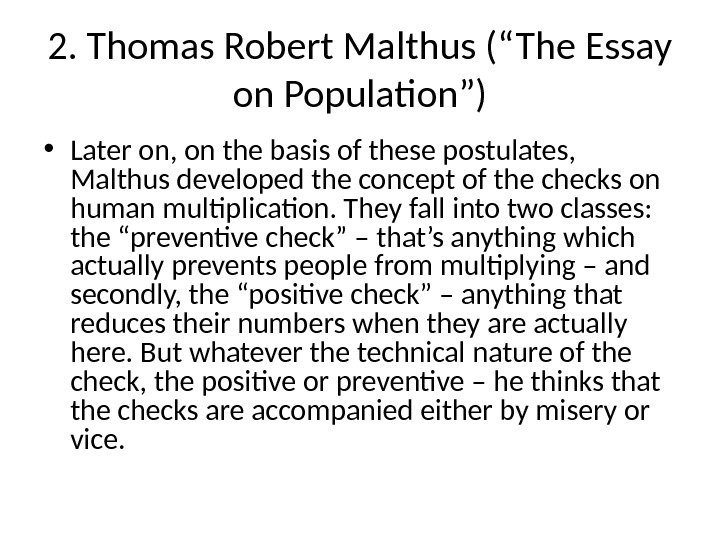
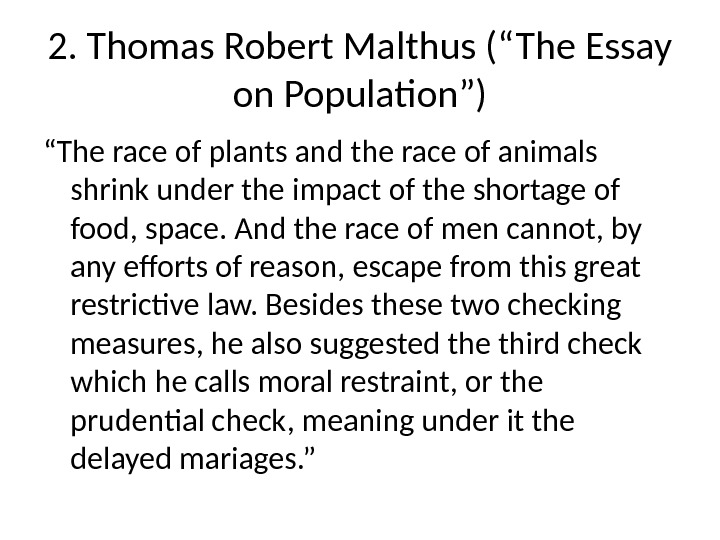



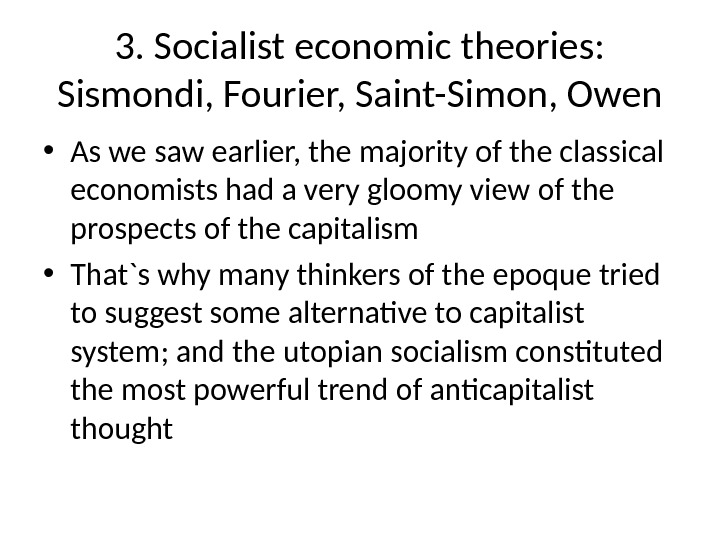

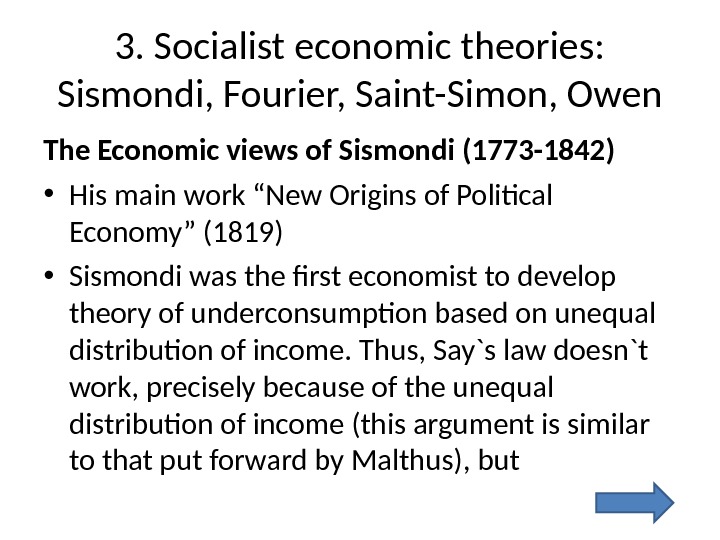

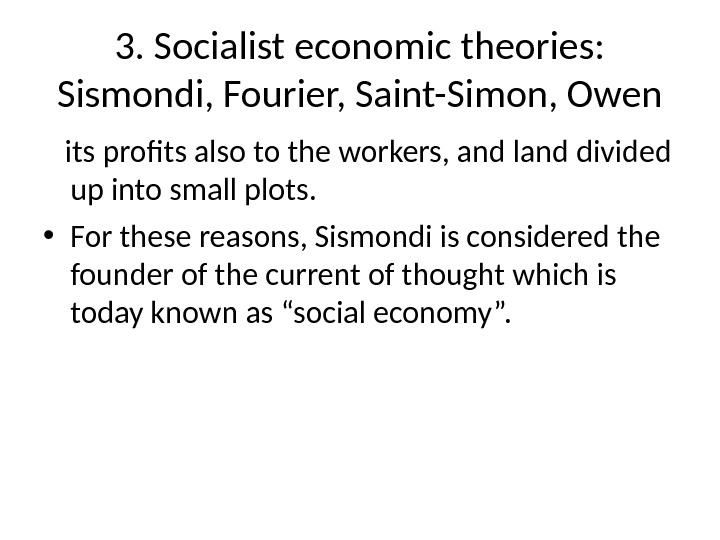
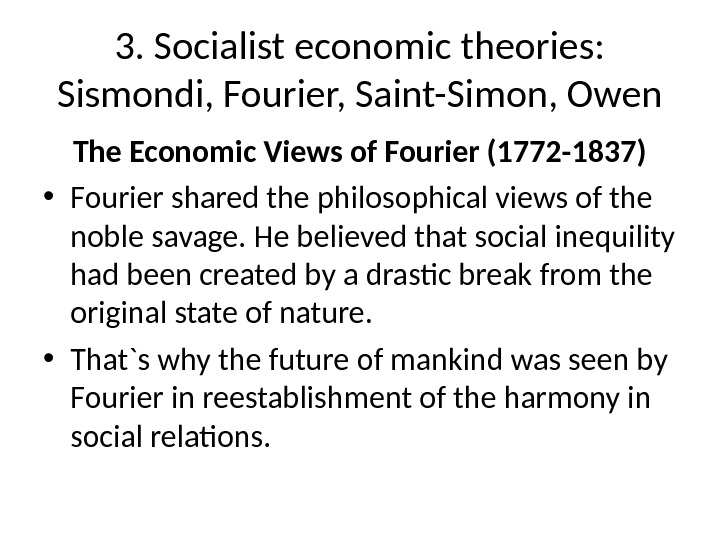

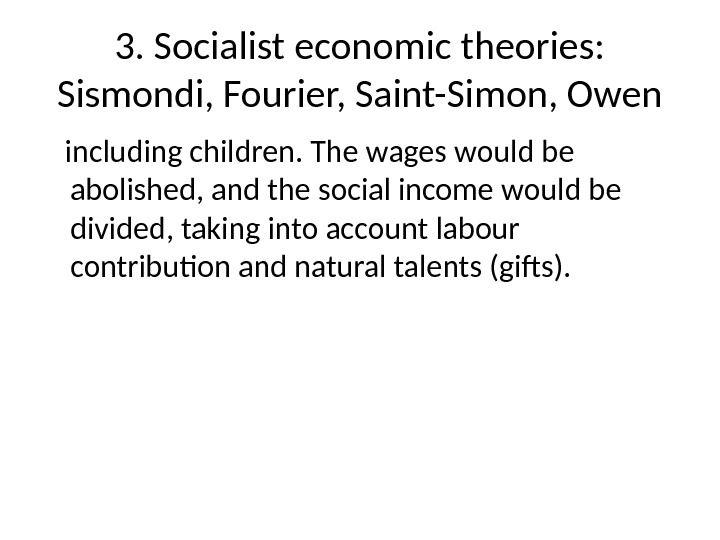




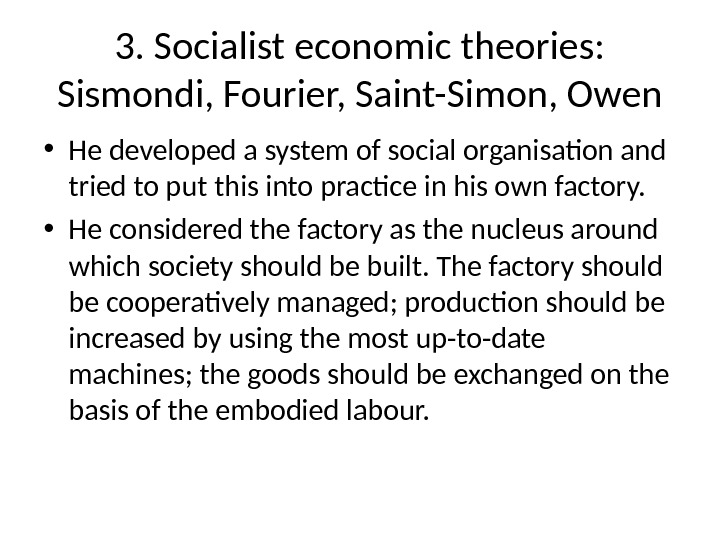


history_of_economic_thought._lecture_4.ppt
- Размер: 397 Кб
- Количество слайдов: 39
Описание презентации Lecture 4 Classical School After Smith and Ricardo по слайдам
 Lecture 4 Classical School After Smith and Ricardo Economic Doctrines of the Utopian Socialists
Lecture 4 Classical School After Smith and Ricardo Economic Doctrines of the Utopian Socialists
 Lecture Plan 1. Jean-Batiste Say (1767 -1832): “The Treatise on Political Economy” 2. Thomas Robert Malthus (“The Essay on Population”) 3. Socialist economic theories: Sismondi, Fourier, Saint-Simon, Owen.
Lecture Plan 1. Jean-Batiste Say (1767 -1832): “The Treatise on Political Economy” 2. Thomas Robert Malthus (“The Essay on Population”) 3. Socialist economic theories: Sismondi, Fourier, Saint-Simon, Owen.
 1. Jean-Batiste Say (1767 -1832): “The Treatise on Political Economy” J. -B. Say on the structure of the Economics and its subject-matter • National economy includes three spheres: production, distribution and consumption; • Economics (as the science that deals with the economy)analyses the economic laws that operate in these three respective spheres: production, distribution and consumption
1. Jean-Batiste Say (1767 -1832): “The Treatise on Political Economy” J. -B. Say on the structure of the Economics and its subject-matter • National economy includes three spheres: production, distribution and consumption; • Economics (as the science that deals with the economy)analyses the economic laws that operate in these three respective spheres: production, distribution and consumption
 1. Jean-Batiste Say (1767 -1832): “The Treatise on Political Economy” • The subject-matter of economics is the cognition of the “authentic nature of the wealth”, i. e. that economics deals with the ways of formation, distribution and consumption of wealth in accordance with needs of the society. • J. -B. Say being Smith`s follower, pronounced against protecting and prohibiting measures that hindered the development of industry and accumulation of people`s wealth, i. e. that he was the dedicated partisan of economic freedom
1. Jean-Batiste Say (1767 -1832): “The Treatise on Political Economy” • The subject-matter of economics is the cognition of the “authentic nature of the wealth”, i. e. that economics deals with the ways of formation, distribution and consumption of wealth in accordance with needs of the society. • J. -B. Say being Smith`s follower, pronounced against protecting and prohibiting measures that hindered the development of industry and accumulation of people`s wealth, i. e. that he was the dedicated partisan of economic freedom
 1. Jean-Batiste Say (1767 -1832): “The Treatise on Political Economy” J. -B. Say on the Source of Wealth • Say put the main accent not on the labour expenditures as the source of income (as Smith did), but on the utility of the goods: “Utility makes goods valuable”, “Production creates utility” • Say disagreed both with phisiocrates and Smith on the nature of productive labour. In accordance with his views, the unique criteria of productivity is utility. That`s why any labour that produces useful goods (even non-material goods) is productive.
1. Jean-Batiste Say (1767 -1832): “The Treatise on Political Economy” J. -B. Say on the Source of Wealth • Say put the main accent not on the labour expenditures as the source of income (as Smith did), but on the utility of the goods: “Utility makes goods valuable”, “Production creates utility” • Say disagreed both with phisiocrates and Smith on the nature of productive labour. In accordance with his views, the unique criteria of productivity is utility. That`s why any labour that produces useful goods (even non-material goods) is productive.
 1. Jean-Batiste Say (1767 -1832): “The Treatise on Political Economy” • The process of production of the goods is nothing but the production and exchange of utilities
1. Jean-Batiste Say (1767 -1832): “The Treatise on Political Economy” • The process of production of the goods is nothing but the production and exchange of utilities
 1. Jean-Batiste Say (1767 -1832): “The Treatise on Political Economy” J. -B. Say: His Theory of the Factors of Production • The above-mentioned Theories of Production and Distribution were linked by J. -B. Say to the Theory of the Factors of Production • The production of goods requires the utilisation of three types of “productive service”: those of labour, capital and land. Value cannot be entirely reduced to labour: all three services contribute to its formation. That`s why the value of the goods depends on the demand the affords to satisfy it. And such efforts require the utilisation of all three of the productive services
1. Jean-Batiste Say (1767 -1832): “The Treatise on Political Economy” J. -B. Say: His Theory of the Factors of Production • The above-mentioned Theories of Production and Distribution were linked by J. -B. Say to the Theory of the Factors of Production • The production of goods requires the utilisation of three types of “productive service”: those of labour, capital and land. Value cannot be entirely reduced to labour: all three services contribute to its formation. That`s why the value of the goods depends on the demand the affords to satisfy it. And such efforts require the utilisation of all three of the productive services
 1. Jean-Batiste Say (1767 -1832): “The Treatise on Political Economy” • Each productive service receives an income that is determined by the demand for the goods it contributes to produce • The intermediary between the product markets and the productive service markets is the entrepreneur (he compares the price that the consumers are prepared to pay for a good with the expenditure necessary to produce it, that is, with the costs of the productive services). In this way, the demand for consumer goods is transformed into demand for productive services
1. Jean-Batiste Say (1767 -1832): “The Treatise on Political Economy” • Each productive service receives an income that is determined by the demand for the goods it contributes to produce • The intermediary between the product markets and the productive service markets is the entrepreneur (he compares the price that the consumers are prepared to pay for a good with the expenditure necessary to produce it, that is, with the costs of the productive services). In this way, the demand for consumer goods is transformed into demand for productive services
 1. Jean-Batiste Say (1767 -1832): “The Treatise on Political Economy” • In so doing, each productive service receives a price (income) which is equal to its productive contribution. Thus, the capitalist economy is not efficient in the allocation of the resources (as stated by theorem of the invisible hand, formulated by A. Smith), but also equitable in the distribution of income • That`s why, in accordance with J. -B. Say`s views, every owner of productive services (factors of production), should be remunerated in due way:
1. Jean-Batiste Say (1767 -1832): “The Treatise on Political Economy” • In so doing, each productive service receives a price (income) which is equal to its productive contribution. Thus, the capitalist economy is not efficient in the allocation of the resources (as stated by theorem of the invisible hand, formulated by A. Smith), but also equitable in the distribution of income • That`s why, in accordance with J. -B. Say`s views, every owner of productive services (factors of production), should be remunerated in due way:
 1. Jean-Batiste Say (1767 -1832): “The Treatise on Political Economy” labourers receive income under the form of wages, landlords – under the form of rent, entrepreneurs – under the form of profit
1. Jean-Batiste Say (1767 -1832): “The Treatise on Political Economy” labourers receive income under the form of wages, landlords – under the form of rent, entrepreneurs – under the form of profit
 1. Jean-Batiste Say (1767 -1832): “The Treatise on Political Economy” Say`s Law • Say tried to demonstrate the impossibility of the market disequilibrium. This is the famous Say` Law, or “Law of Markets”, according to which supply always create its own demand (production is always equal to consumption) • Say pointed out that the value of the aggregate production is necessarily equal to the value of the distributed incomes
1. Jean-Batiste Say (1767 -1832): “The Treatise on Political Economy” Say`s Law • Say tried to demonstrate the impossibility of the market disequilibrium. This is the famous Say` Law, or “Law of Markets”, according to which supply always create its own demand (production is always equal to consumption) • Say pointed out that the value of the aggregate production is necessarily equal to the value of the distributed incomes
 1. Jean-Batiste Say (1767 -1832): “The Treatise on Political Economy” • It means that the produced goods always create the purchasing power corresponding to their value, i. e. the production creates its own demand “ It must be stressed that any commodity whatsoever, as soon as it is brought to the market, offers an outlet for other products for the whole amount of its value. In fact, when a manufacturer has produced a commodity, he has an extreme need and wish to sell it, so that its value does not dissolve in his hands.
1. Jean-Batiste Say (1767 -1832): “The Treatise on Political Economy” • It means that the produced goods always create the purchasing power corresponding to their value, i. e. the production creates its own demand “ It must be stressed that any commodity whatsoever, as soon as it is brought to the market, offers an outlet for other products for the whole amount of its value. In fact, when a manufacturer has produced a commodity, he has an extreme need and wish to sell it, so that its value does not dissolve in his hands.
 1. Jean-Batiste Say (1767 -1832): “The Treatise on Political Economy” Say`s Law but he is no less willing to get rid of the money he obtained from the sale of the commodity, precisely in order to prevent the value of the money vanishing by remaining idle. Now, one cannot get rid of one`s own money except by purchasing some product. Therefore it is clear that the very production of a commodity immediately opens an outlet to other products. ”
1. Jean-Batiste Say (1767 -1832): “The Treatise on Political Economy” Say`s Law but he is no less willing to get rid of the money he obtained from the sale of the commodity, precisely in order to prevent the value of the money vanishing by remaining idle. Now, one cannot get rid of one`s own money except by purchasing some product. Therefore it is clear that the very production of a commodity immediately opens an outlet to other products. ”
 1. Jean-Batiste Say (1767 -1832): “The Treatise on Political Economy” Say`s Law • From this citation follows that the purchasing power generated from the production process is no-longer only potential demand ; it is also, and always, effective demand. That`s why the situations of aggregate access supply are impossible. Say`s law excludes the possibility of crisis or general gluts. It also excludes unemployment.
1. Jean-Batiste Say (1767 -1832): “The Treatise on Political Economy” Say`s Law • From this citation follows that the purchasing power generated from the production process is no-longer only potential demand ; it is also, and always, effective demand. That`s why the situations of aggregate access supply are impossible. Say`s law excludes the possibility of crisis or general gluts. It also excludes unemployment.
 1. Jean-Batiste Say (1767 -1832): “The Treatise on Political Economy” Say`s Law • In so doing, Say`s law is based on two very simple propositions: first, he believed, that the desire for commodities is infinite; the desire for food may be limited by the capacity of a man` s stomach, as Adam Smith had said; but his desire for clothes, furniture, luxuries, and ornaments seemed incalculably large. Secondly, Say said that the ability to purchase was guaranteed as well. For every good that was produced, cost something – and every cost was some man`s income, whether the cost was wages, rent or profits, its sale price accrued as someone`s income. So, how could a general glut ever occur? The demand for goods existed, and the incomes to buy them existed as well
1. Jean-Batiste Say (1767 -1832): “The Treatise on Political Economy” Say`s Law • In so doing, Say`s law is based on two very simple propositions: first, he believed, that the desire for commodities is infinite; the desire for food may be limited by the capacity of a man` s stomach, as Adam Smith had said; but his desire for clothes, furniture, luxuries, and ornaments seemed incalculably large. Secondly, Say said that the ability to purchase was guaranteed as well. For every good that was produced, cost something – and every cost was some man`s income, whether the cost was wages, rent or profits, its sale price accrued as someone`s income. So, how could a general glut ever occur? The demand for goods existed, and the incomes to buy them existed as well
 1. Jean-Batiste Say (1767 -1832): “The Treatise on Political Economy” Say`s Law • As far as money is concerned, it is a mere mediator that facilitates the process of exchange. Money does not have its own value and fulfills an exclusively technical role. • Should economic crises appears, it is determined by only one reason: structural disbalance (the production of some goods is not sufficient). This disbalance is of temporary character: it is overcome due to absolute flexibility of prices, wages and rate of interest.
1. Jean-Batiste Say (1767 -1832): “The Treatise on Political Economy” Say`s Law • As far as money is concerned, it is a mere mediator that facilitates the process of exchange. Money does not have its own value and fulfills an exclusively technical role. • Should economic crises appears, it is determined by only one reason: structural disbalance (the production of some goods is not sufficient). This disbalance is of temporary character: it is overcome due to absolute flexibility of prices, wages and rate of interest.
 2. Thomas Robert Malthus (“The Essay on Population”) • His “Essay on Population” (1798) was published anonimously and it contained theory that was direct result of a hostile reaction to the utopian speculation an the utopian optimism that accompanied the first years of the French Revolution. • Malthus begins by laying down two postulates. The first is: “That food is necessary for the existence of men”; the second is: “the power of population to increase is indefinetely greater than the power in the earth to produce subsistence for men”.
2. Thomas Robert Malthus (“The Essay on Population”) • His “Essay on Population” (1798) was published anonimously and it contained theory that was direct result of a hostile reaction to the utopian speculation an the utopian optimism that accompanied the first years of the French Revolution. • Malthus begins by laying down two postulates. The first is: “That food is necessary for the existence of men”; the second is: “the power of population to increase is indefinetely greater than the power in the earth to produce subsistence for men”.
 2. Thomas Robert Malthus (“The Essay on Population”) • This argument is substantiated by the following: “Population, when unchecked, increases in geometrical ratio, and subsistence for men – in arithmetical ratio”. And further on, Malthus pointed out that population doubled every 25 years while production of means of subsistence was considerably lagging behind.
2. Thomas Robert Malthus (“The Essay on Population”) • This argument is substantiated by the following: “Population, when unchecked, increases in geometrical ratio, and subsistence for men – in arithmetical ratio”. And further on, Malthus pointed out that population doubled every 25 years while production of means of subsistence was considerably lagging behind.
 2. Thomas Robert Malthus (“The Essay on Population”) • The above-mentioned arguments laid down the basis for the following conclusion: poverty results from this gap between the rates of growth of population and means of subsistence. That`s why any help to poor people was devoid of any sense, because it would, in the long run, stimulate, ever higher, birthrates.
2. Thomas Robert Malthus (“The Essay on Population”) • The above-mentioned arguments laid down the basis for the following conclusion: poverty results from this gap between the rates of growth of population and means of subsistence. That`s why any help to poor people was devoid of any sense, because it would, in the long run, stimulate, ever higher, birthrates.
 2. Thomas Robert Malthus (“The Essay on Population”) • Later on, on the basis of these postulates, Malthus developed the concept of the checks on human multiplication. They fall into two classes: the “preventive check” – that’s anything which actually prevents people from multiplying – and secondly, the “positive check” – anything that reduces their numbers when they are actually here. But whatever the technical nature of the check, the positive or preventive – he thinks that the checks are accompanied either by misery or vice.
2. Thomas Robert Malthus (“The Essay on Population”) • Later on, on the basis of these postulates, Malthus developed the concept of the checks on human multiplication. They fall into two classes: the “preventive check” – that’s anything which actually prevents people from multiplying – and secondly, the “positive check” – anything that reduces their numbers when they are actually here. But whatever the technical nature of the check, the positive or preventive – he thinks that the checks are accompanied either by misery or vice.
 2. Thomas Robert Malthus (“The Essay on Population”) “ The race of plants and the race of animals shrink under the impact of the shortage of food, space. And the race of men cannot, by any efforts of reason, escape from this great restrictive law. Besides these two checking measures, he also suggested the third check which he calls moral restraint, or the prudential check, meaning under it the delayed mariages. ”
2. Thomas Robert Malthus (“The Essay on Population”) “ The race of plants and the race of animals shrink under the impact of the shortage of food, space. And the race of men cannot, by any efforts of reason, escape from this great restrictive law. Besides these two checking measures, he also suggested the third check which he calls moral restraint, or the prudential check, meaning under it the delayed mariages. ”
 2. Thomas Robert Malthus (“The Essay on Population”) • As it may be easily seen from the previous statements, Malthus, in fact, was basing his concept on the simple law of diminishing returns, or, in other words, the productivity of earth increases everless whith each new unit of investments of capital and labour, while the growth of population is not limited by this law • The Malthus`s “Essay on Population” provoked very animated discussion on the future of mankind. Malthus sticked to the point that the growth of population can be limited by only one factor: shortage of the means of subsistence. In fact, the situation is quite different: the emuleration of well-being of the population leads to the decrease of the birthrate an concious family-planning.
2. Thomas Robert Malthus (“The Essay on Population”) • As it may be easily seen from the previous statements, Malthus, in fact, was basing his concept on the simple law of diminishing returns, or, in other words, the productivity of earth increases everless whith each new unit of investments of capital and labour, while the growth of population is not limited by this law • The Malthus`s “Essay on Population” provoked very animated discussion on the future of mankind. Malthus sticked to the point that the growth of population can be limited by only one factor: shortage of the means of subsistence. In fact, the situation is quite different: the emuleration of well-being of the population leads to the decrease of the birthrate an concious family-planning.
 2. Thomas Robert Malthus (“The Essay on Population”) • But, nevertheless, the problem, formulated by Malthus, has not lost its importance for the modern world, taking into account the globalisation process and the present day aggravation of the food-stuff shortage in the modern world.
2. Thomas Robert Malthus (“The Essay on Population”) • But, nevertheless, the problem, formulated by Malthus, has not lost its importance for the modern world, taking into account the globalisation process and the present day aggravation of the food-stuff shortage in the modern world.
 3. Socialist economic theories: Sismondi, Fourier, Saint-Simon, Owen • The first decades of the XIX-th century gave rise to the upsurge of the socialist economic theories, later on called the Utopian socialism. • The fundamental reason that accounted for its appearance was the visible aggravation of the contradictions of the capitalism of that epoque.
3. Socialist economic theories: Sismondi, Fourier, Saint-Simon, Owen • The first decades of the XIX-th century gave rise to the upsurge of the socialist economic theories, later on called the Utopian socialism. • The fundamental reason that accounted for its appearance was the visible aggravation of the contradictions of the capitalism of that epoque.
 3. Socialist economic theories: Sismondi, Fourier, Saint-Simon, Owen • As we saw earlier, the majority of the classical economists had a very gloomy view of the prospects of the capitalism • That`s why many thinkers of the epoque tried to suggest some alternative to capitalist system; and the utopian socialism constituted the most powerful trend of anticapitalist thought
3. Socialist economic theories: Sismondi, Fourier, Saint-Simon, Owen • As we saw earlier, the majority of the classical economists had a very gloomy view of the prospects of the capitalism • That`s why many thinkers of the epoque tried to suggest some alternative to capitalist system; and the utopian socialism constituted the most powerful trend of anticapitalist thought
 3. Socialist economic theories: Sismondi, Fourier, Saint-Simon, Owen • The majority of utopian socialists were convinced that capitalist system could not be improved without changing the character of property.
3. Socialist economic theories: Sismondi, Fourier, Saint-Simon, Owen • The majority of utopian socialists were convinced that capitalist system could not be improved without changing the character of property.
 3. Socialist economic theories: Sismondi, Fourier, Saint-Simon, Owen The Economic views of Sismondi (1773 -1842) • His main work “New Origins of Political Economy” (1819) • Sismondi was the first economist to develop theory of underconsumption based on unequal distribution of income. Thus, Say`s law doesn`t work, precisely because of the unequal distribution of income (this argument is similar to that put forward by Malthus), but
3. Socialist economic theories: Sismondi, Fourier, Saint-Simon, Owen The Economic views of Sismondi (1773 -1842) • His main work “New Origins of Political Economy” (1819) • Sismondi was the first economist to develop theory of underconsumption based on unequal distribution of income. Thus, Say`s law doesn`t work, precisely because of the unequal distribution of income (this argument is similar to that put forward by Malthus), but
 3. Socialist economic theories: Sismondi, Fourier, Saint-Simon, Owen Sismondi proposed to solve the problem by redistributing wealth, not from the capitalists to the land owners but rather from the capitalists to the workers, through state intervention. • Sismondi did not advocate revolution and abolition of private property. He saw the future of the society as the social order dominated by small agricultural and craft producers, with an industry which distributed
3. Socialist economic theories: Sismondi, Fourier, Saint-Simon, Owen Sismondi proposed to solve the problem by redistributing wealth, not from the capitalists to the land owners but rather from the capitalists to the workers, through state intervention. • Sismondi did not advocate revolution and abolition of private property. He saw the future of the society as the social order dominated by small agricultural and craft producers, with an industry which distributed
 3. Socialist economic theories: Sismondi, Fourier, Saint-Simon, Owen its profits also to the workers, and land divided up into small plots. • For these reasons, Sismondi is considered the founder of the current of thought which is today known as “social economy”.
3. Socialist economic theories: Sismondi, Fourier, Saint-Simon, Owen its profits also to the workers, and land divided up into small plots. • For these reasons, Sismondi is considered the founder of the current of thought which is today known as “social economy”.
 3. Socialist economic theories: Sismondi, Fourier, Saint-Simon, Owen The Economic Views of Fourier (1772 -1837) • Fourier shared the philosophical views of the noble savage. He believed that social inequility had been created by a drastic break from the original state of nature. • That`s why the future of mankind was seen by Fourier in reestablishment of the harmony in social relations.
3. Socialist economic theories: Sismondi, Fourier, Saint-Simon, Owen The Economic Views of Fourier (1772 -1837) • Fourier shared the philosophical views of the noble savage. He believed that social inequility had been created by a drastic break from the original state of nature. • That`s why the future of mankind was seen by Fourier in reestablishment of the harmony in social relations.
 3. Socialist economic theories: Sismondi, Fourier, Saint-Simon, Owen • This harmony was to be based on liberation of labour. It means the abolition of profit and capital and abolition of wages and labour. In so doing, society would be liberated from the exploitation and alienation. • The future social order would be composed of the associations of the producers. And each association would combine agricultural labour and industrial labour. Labour would be obligatory for all the members of the society,
3. Socialist economic theories: Sismondi, Fourier, Saint-Simon, Owen • This harmony was to be based on liberation of labour. It means the abolition of profit and capital and abolition of wages and labour. In so doing, society would be liberated from the exploitation and alienation. • The future social order would be composed of the associations of the producers. And each association would combine agricultural labour and industrial labour. Labour would be obligatory for all the members of the society,
 3. Socialist economic theories: Sismondi, Fourier, Saint-Simon, Owen including children. The wages would be abolished, and the social income would be divided, taking into account labour contribution and natural talents (gifts).
3. Socialist economic theories: Sismondi, Fourier, Saint-Simon, Owen including children. The wages would be abolished, and the social income would be divided, taking into account labour contribution and natural talents (gifts).
 3. Socialist economic theories: Sismondi, Fourier, Saint-Simon, Owen The Economic Views of Saint-Simon (1760 -1825) • The main economic work “On industrial system” (1822). • Saint-Simon was considered as a sort of “apostle of industrialism”. • Saint-Simon considered the industrialists as the basis of the society: “If all the kings and
3. Socialist economic theories: Sismondi, Fourier, Saint-Simon, Owen The Economic Views of Saint-Simon (1760 -1825) • The main economic work “On industrial system” (1822). • Saint-Simon was considered as a sort of “apostle of industrialism”. • Saint-Simon considered the industrialists as the basis of the society: “If all the kings and
 3. Socialist economic theories: Sismondi, Fourier, Saint-Simon, Owen all the apparatus of courts were to die, what difference would it make to the rest of the society? Whereas, if the leading industrialists were to die, the society would collapse. ” • Contrary to the classics, Saint-Simon put the main accent not on the distribution of incomes, but on the distribution of property. Social unequility would be overcome through justiful distribution of the material wealth.
3. Socialist economic theories: Sismondi, Fourier, Saint-Simon, Owen all the apparatus of courts were to die, what difference would it make to the rest of the society? Whereas, if the leading industrialists were to die, the society would collapse. ” • Contrary to the classics, Saint-Simon put the main accent not on the distribution of incomes, but on the distribution of property. Social unequility would be overcome through justiful distribution of the material wealth.
 3. Socialist economic theories: Sismondi, Fourier, Saint-Simon, Owen • The share of every person was to be determined by his or her labour contribution and capital contribution.
3. Socialist economic theories: Sismondi, Fourier, Saint-Simon, Owen • The share of every person was to be determined by his or her labour contribution and capital contribution.
 3. Socialist economic theories: Sismondi, Fourier, Saint-Simon, Owen The Economic Views of R. Owen (1771 -1858) • Robert Owen was inspired by a pessimistic of man. He did not recognize in human kind any natural aspiration to liberty. • But at the same time he thought that the character of man could be changed by modifying his living conditions. • Contrary to Fourier, Owen pronounced against private property.
3. Socialist economic theories: Sismondi, Fourier, Saint-Simon, Owen The Economic Views of R. Owen (1771 -1858) • Robert Owen was inspired by a pessimistic of man. He did not recognize in human kind any natural aspiration to liberty. • But at the same time he thought that the character of man could be changed by modifying his living conditions. • Contrary to Fourier, Owen pronounced against private property.
 3. Socialist economic theories: Sismondi, Fourier, Saint-Simon, Owen • He developed a system of social organisation and tried to put this into practice in his own factory. • He considered the factory as the nucleus around which society should be built. The factory should be cooperatively managed; production should be increased by using the most up-to-date machines; the goods should be exchanged on the basis of the embodied labour.
3. Socialist economic theories: Sismondi, Fourier, Saint-Simon, Owen • He developed a system of social organisation and tried to put this into practice in his own factory. • He considered the factory as the nucleus around which society should be built. The factory should be cooperatively managed; production should be increased by using the most up-to-date machines; the goods should be exchanged on the basis of the embodied labour.
 3. Socialist economic theories: Sismondi, Fourier, Saint-Simon, Owen • The highest stage (the peak of the development of the socialist economic theories is presented by the Economic Doctrine of Karl Marx, elaborated mainly in his “Das Kapital” (“The Capital”) • Contrary to the above analysed views of Sismondi and other socialist economic thinkers, the economic views of Karl Marx were called the Scientific Socialism.
3. Socialist economic theories: Sismondi, Fourier, Saint-Simon, Owen • The highest stage (the peak of the development of the socialist economic theories is presented by the Economic Doctrine of Karl Marx, elaborated mainly in his “Das Kapital” (“The Capital”) • Contrary to the above analysed views of Sismondi and other socialist economic thinkers, the economic views of Karl Marx were called the Scientific Socialism.
 3. Socialist economic theories: Sismondi, Fourier, Saint-Simon, Owen • We shall analyse the essence of Marx`s economic doctrine at the next lecture.
3. Socialist economic theories: Sismondi, Fourier, Saint-Simon, Owen • We shall analyse the essence of Marx`s economic doctrine at the next lecture.
